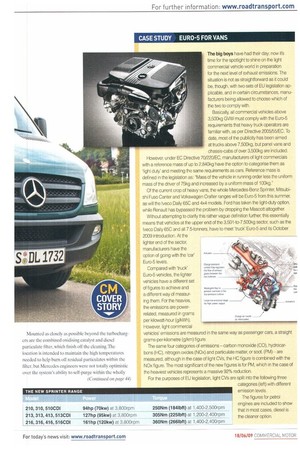CASE STUDY EURO-5 FOR VANS
Page 43

If you've noticed an error in this article please click here to report it so we can fix it.
The big boys have had their day; now its time for the spotlight to shine on the light commercial vehicle world in preparation for the next level of exhaust emissions. The situation is not as straightforward as it could be, though, with two sets of EU legislation applicable, and in certain circumstances, manufacturers being allowed to choose which of the two to comply with.
Basically, all commercial vehicles above 3,500kg GVW must comply with the Euro-5 requirements that heavy truck operators are familiar with, as per Directive 2005/55/E0. To date, most of the publicity has been aimed at trucks above 7,500kg, but panel vans and chassis-cabs of over 3,500kg are included. However under EC Directive 70/220/EC, manufacturers of light commercials with a reference mass of up to 2,840kg have the option to categorise them as 'light duty' and meeting the same requirements as cars. Reference mass is defined in the legislation as: "Mass of the vehicle in running order less the uniform mass of the driver of 75kg and increased by a uniform mass of 100kg." Of the current crop of heavy vans, the whole Mercedes-Benz Sprinter, Mitsubishi Fuso Canter and Volkswagen Crafter ranges will be Euro-5 from this summer, as will the Iveco Daily 65C and 4x4 models. Ford has taken the light-duty option, while Renault has bypassed the problem by dropping the Mascott altogether. Without attempting to clarify this rather vague definition further, this essentially means that vehicles at the upper end of the 3,501-to-7,500kg sector, such as the Iveco Daily 65C and all 7.5-tonners, have to meet 'truck' Euro-5 and its October 2009 introduction. At the lighter end of the sector, manufacturers have the option of going with the 'car' Euro-5 levels.
Gbafge ',pule
■ reemodw,
Compared with 'truck' Euro-5 vehicles, the lighter vehicles have a different set of figures to achieve and a different way of measuring them. For the heavies, the emissions are powerrelated, measured in grams per kilowatt-hour (g/kVVh). However, light commercial vehicles' emissions are measured in the same way as passenger cars, a straight grams-per-kilometre (g/krn) figure.
The same four categories of emissions carbon monoxide (CO), hydrocarbons (HC), nitrogen oxides (N0x) and particulate matter, or soot, (PM) are measured, although in the case of light CVs, the HC figure is combined with the NOx figure. The most significant of the new figures is for PM, which in the case of the heaviest vehicles represents a massive 92% reduction.
For the purposes of EU legislation, light CVs are split into the following three categories (left) with different emission levels.
The figures for petrol engines are included to show that in most cases, diesel is the cleaner option.
























































































































































